The British pound is lower against the euro on Tuesday.
- Cunliffe says “Negative rates are one possible tool” for Bank of England
- German trade balance craters in April
- Fading investor optimism before Fed meeting
- Pound-euro exchange flat at -0.04% this week
GBP/EUR was lower by 42 pips (-0.40%) to 1.1216 as of 3pm GMT.
The currency pair reached highs of 1.127 before erasing the gains and turning lower on the day, only finding support at 1.12.
GBP: Cunliffe calls negative rates “possible tool”
Some more downbeat comments from a British central banker acted as a weight on Sterling on Tuesday, as did a more ‘risk-off’ tone in markets that dragged European shares into the red for a second day.
The Bank of England’s Jon Cunliffe told the Investment Association that the the Covid-19 crisis is “very far from over” and that there is likely to be great deal of pain for financial sector, noting that UK money market funds source of vulnerability.
He also reiterated comments from Governor Andrew Bailey on negative rates, saying they “are one possible tool the Bank of England might use to support demand.” Cunliffe was also cautious about the latest data showing some economic recovery over April saying “It is very early to say what this means for recovery in Q3 and Q4.”
EUR: Germany trade balance craters
The euro fared well in the face of growing evidence of just what a rough month April was for Germany’s economy. On Tuesday, data revealed that Germany’s trade balance plummeted to €3.2 billion versus the €11.6 billion expected, owing to a -24.0% plunge in exports, much greater than the -15.6% forecast by economists.
The depth of the downturn in April during lockdown adds extra weight to the progress in the economic reopening that has fuelled a return in optimism across markets in the past few weeks.
ECB Executive board member Isabel Schnabel may have offered some support to the euro suggesting that “bond buying is currently more effective than negative rates,” although she added that “lowering interest rates remain an option for future.”





